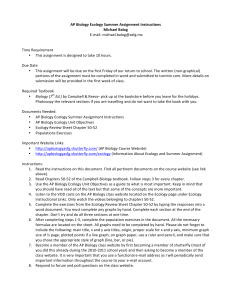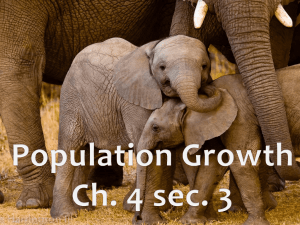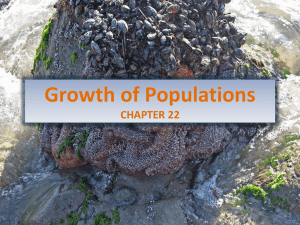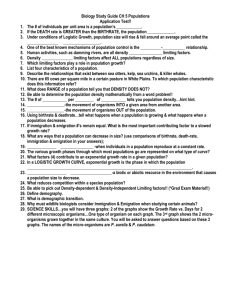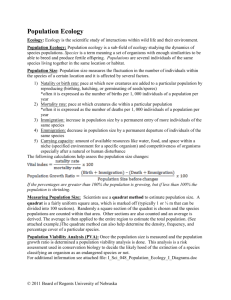AP Biology Ecology Summer Assignment Instructions Required
advertisement
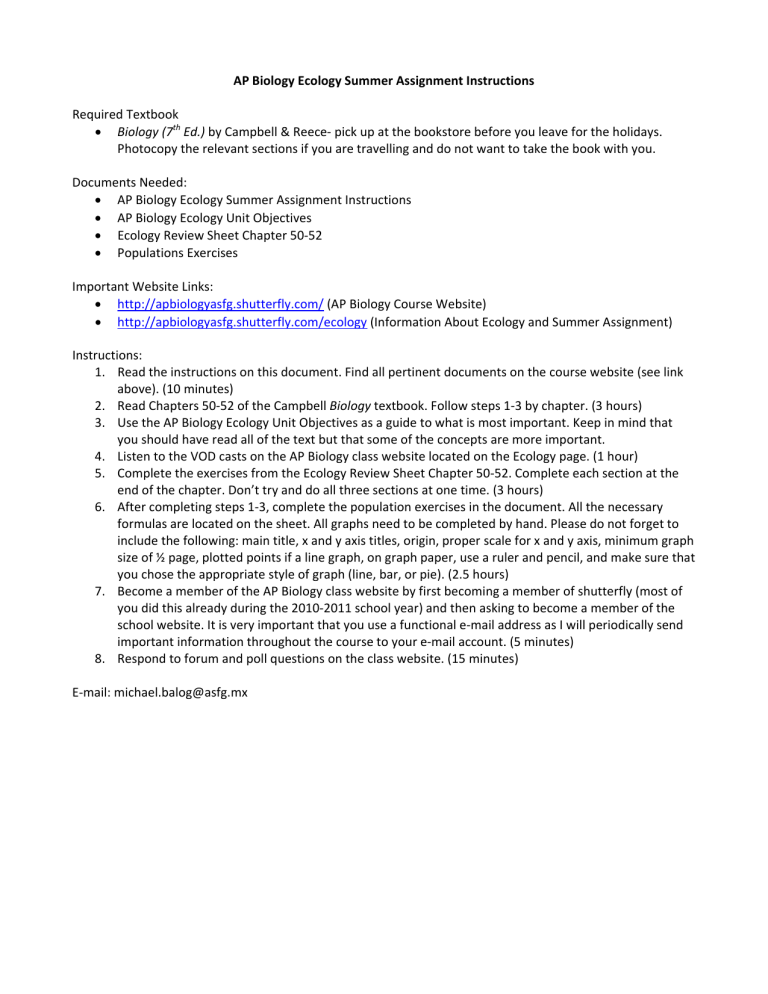
AP Biology Ecology Summer Assignment Instructions Required Textbook • Biology (7th Ed.) by Campbell & Reece‐ pick up at the bookstore before you leave for the holidays. Photocopy the relevant sections if you are travelling and do not want to take the book with you. Documents Needed: • AP Biology Ecology Summer Assignment Instructions • AP Biology Ecology Unit Objectives • Ecology Review Sheet Chapter 50‐52 • Populations Exercises Important Website Links: • http://apbiologyasfg.shutterfly.com/ (AP Biology Course Website) • http://apbiologyasfg.shutterfly.com/ecology (Information About Ecology and Summer Assignment) Instructions: 1. Read the instructions on this document. Find all pertinent documents on the course website (see link above). (10 minutes) 2. Read Chapters 50‐52 of the Campbell Biology textbook. Follow steps 1‐3 by chapter. (3 hours) 3. Use the AP Biology Ecology Unit Objectives as a guide to what is most important. Keep in mind that you should have read all of the text but that some of the concepts are more important. 4. Listen to the VOD casts on the AP Biology class website located on the Ecology page. (1 hour) 5. Complete the exercises from the Ecology Review Sheet Chapter 50‐52. Complete each section at the end of the chapter. Don’t try and do all three sections at one time. (3 hours) 6. After completing steps 1‐3, complete the population exercises in the document. All the necessary formulas are located on the sheet. All graphs need to be completed by hand. Please do not forget to include the following: main title, x and y axis titles, origin, proper scale for x and y axis, minimum graph size of ½ page, plotted points if a line graph, on graph paper, use a ruler and pencil, and make sure that you chose the appropriate style of graph (line, bar, or pie). (2.5 hours) 7. Become a member of the AP Biology class website by first becoming a member of shutterfly (most of you did this already during the 2010‐2011 school year) and then asking to become a member of the school website. It is very important that you use a functional e‐mail address as I will periodically send important information throughout the course to your e‐mail account. (5 minutes) 8. Respond to forum and poll questions on the class website. (15 minutes) E‐mail: michael.balog@asfg.mx AP Biology Ecology Unit Objectives Chapter 50 Introduction to Ecology 3 Most Important Concepts: 1. Abiotic and biotic factors affect species range, distribution and abundance. 2. Many global processes affect the distribution and abundance of abiotic factors such as air and water currents. 3. Biomes are broad geographic areas of similar ecological components. You need to know: • Examples of abiotic and biotic factors • The difference between species distribution and abundance. • The levels of biological organization (p.4 and 5) • The difference between environmentalism and ecology • Dispersal and the limits to species range (fig 50.6 on p. 1084) • Species transplants • Behavioral and biotic factors that affect species distribution • Abiotic factors that affect species distribution • Seasons are generated by Earth’s axial tilt, not distance from the sun • Air circulation affects global precipitation patterns • General characteristics of the different marine biomes (p. 1094 to 1097) • General characteristics of the different terrestrial biomes (p. 1100 to 1103) Important Terms: Abiotic, Biotic, Biota, Population, Community, Ecosystem, Biosphere, Dispersal, Climate, Biomes, Photic zone, Aphotic zone, Detritus Chapter 51 Behavioral Ecology 3 Most Important Concepts: 1. Many behaviors are predetermined or are heavily influenced by genetic factors. 2. Behavioral traits can evolve by natural selection where behaviors that favor increased reproductive success are promoted. 3. The environment can influence the development of behaviors, most importantly where behavior is influenced by experiences (learning). You need to know: • The difference between proximate and ultimate causes • The difference between a fixed action pattern and imprinting • Examples of the different types of behavior that are influenced by genes • Cool: monogamy in prairie voles‐ don’t have to know specifically but it should cause you to think about many behaviors that we think are learned that have a genetic background as well • Behavior can be affected by diet, social environment • Most important: Different types of learning • Impact of natural selection on the evolution of behaviors • Foraging behavior (more successful at getting food, more chances to mate, more offspring) specifics such as optimal foraging theory and the experiments that demonstrate adaptive behaviors • Concept of inclusive fitness and its ability to account for altruism • Examples of social learning Important Terms: Behavioral ecology, proximate questions, ultimate questions, fixed action patterns, sign stimulus, imprinting, sensitive period, innate behaviors, kinesis, taxis, pheromones, learning, habituation, spatial learning, associative learning (classical conditioning, operant conditioning), cognition, foraging, optimal foraging theory, promiscuous, monogamous, polygamous, agnostic behavior, altruism, inclusive fitness, reciprocal altruism, social learning Chapter 52 Population Ecology 3 Most Important Concepts: 1. Multiple factors influence the overall size and distribution of a population. 2. The exponential model of growth describes population growth in an idealized, unlimited environment. 3. K‐selection and r‐selection are different population growth patterns based on differences in life strategies for individual members of the species. You Need to Know: • • • • • • • Difference between density and dispersion Mark and recapture method How immigration, emigration, births and deaths can influence a population size Patterns of dispersion Survivorship curves Big bang reproduction contrasted with repeated reproduction J‐shaped curve represents exponential growth (what is necessary for exponential growth) • Carrying capacity and logistic population growth • • (Δ N) = (births + immigration) ‐ (deaths + emigration) Percent growth = [b + i] ‐ [ d + e] x 100% Initial population • Population Density Dp = N/A or Dp = N/V • The rate of change can be calculated by the formula R = D/t (D = Density, N = number of organisms, A= area, V = volume) (t = time, D = density) • K‐ selection (density dependant) characteristics and r‐selection (density independent) characteristics ∙∙∙∙see powerpoint population genetics notes • Factors regulating growth of density dependent population growth curves • Human population characteristics and reading histograms Important Terms: Population ecology, density, dispersion, mark‐recapture method, immigration, emigration, demographics, survivorship curves, life history, zero‐population growth, exponential growth, carrying capacity, logistic growth, K/r selection, density dependant, density independent, ecological footprint, ecological capacity Ecology Review Package Chapter 50‐52 Note: This review package does not include questions on all of the content located within the ecology chapters. Please refer to AP Biology Ecology Unit Objectives for that list. Chapter 50 1. Give an example of how an abiotic factor could affect a specific species range, distribution, and abundance. Provide an example of how a biotic factor could affect a species range, distribution, and abundance. 2. What are the levels of biological organization and give one example of each. 3. Describe a global process that can affect the distribution and abundance of an abiotic factor. 4. Many factors affect the oxygen concentration found in lakes that experience seasonal turnover. In a laboratory cold water contains higher concentrations of gases, but remember that a lake is an ecosystem with living things and this might not always be the case. Fill in the following table: Summer Fall Winter Spring Area of high oxygen concentration Reason for high oxygen concentration Area of low oxygen concentration Reason for low oxygen concentration 5. What is eutrophication? What causes it? How does it affect oxygen concentrations of lakes? 6. Fill in the table regarding biomes: Biome Temperature and Common Plants Common Animals Adaptations of an Precipitation Animal or Plant that aid in its survival Tropical Forest Savanna Temperate Grassland Temperate Broadleaf (deciduous) Forest Coniferous (pine) Forest Desert Chaparral Tundra High Mountains Chapter 51 1. What is the difference between an innate and a learned behavior? 2. Give 2 examples of behaviors that have evolved as a result of natural selection? Describe the process of natural selection specific to each situation. Remember that some adaptations increase the probability of survival, which increases the probability of finding a mater, which increase the probability of producing offspring, which increases the probability of passing on the adaptation (gene) to subsequent generations. After a long time and many generations, the population begins to…. 3. Compare and contrast fixed action patterns with imprinting? 4. Compare and contrast kinesis, taxis, and migration? How could each have evolved as a result of natural selection? 5. What types of communication are animals capable of? What is the evolutionary significance of these behaviors? Is communication the same as language? Why? 6. Learning can be classified in many different ways. Fill in the following table: Type of Learning Definition Example How this type of learning capacity would increase survival probabilities? Habituation Spatial Learning Cognitive Maps Associative Learning Cognition and Problem Solving 7. What factors influence an organisms feeding behavior? Describe a hypothetical example. 8. Describe three abiotic or biotic factors that can influence the mating behavior of animals? 9. How can inclusive fitness account for altruism in species? 10. How does social learning differ from other types of learning? Chapter 52 1. What are all the factors described in the text that can explain differences in population size and distribution? 2. What is the difference between density and dispersion? 3. What are the different dispersion patterns and provide an example (not from the text) that illustrates this type of dispersion pattern? 4. What would need to happen in order for a population to experience exponential growth? 5. What is the carrying capacity and how does it affect logistical growth patterns? 6. What are abiotic and biotic factors that can affect the carrying capacity? Which of the previously listed factors are density dependent and which are density independent? 7. Use the following table to compare population characteristics for r‐selected and k‐selected species. Give an example of each. Characteristic r‐selected k‐selected Density Independent Growth or Density Dependent Growth Limiting Resource Territoriality Reach maturity when Lifespan Mating Frequency Parental Care Litter Size Offspring Size Survivorship (death rate) 8. What types of events can cause fluctuations in population size? POPULATIONS EXERCISE ONE: PREDATION OR STARVATION Background Information In 1960 the deer population of an island forest reserve about 200 square miles in size was about 2,000 animals. Although the island had excellent vegetation for feeding, the food supply obviously had limits. Thus the forest management personnel feared that overgrazing might lead to mass starvation. Since the area was too remote for hunters, the wildlife service decided to bring in natural predators to control the deer population. It was hoped that, eventually, natural predation would eliminate the weakest deer, thereby preventing the herd from becoming too large, while at the same time increasing the quality of the herd. In 1961, 10 wolves were flown into the island. Formulas • (Δ N) = (births + immigration) ‐ (deaths + emigration) • Percent growth = [b + i] ‐ [ d + e] x 100% Initial population • Population Density Dp = N/A or Dp = N/V (D = Density, N = number of organisms, A= area, V = volume) • The rate of change can be calculated by the formula R = D/t (t = time, D = density) Data The results of this natural predator program are presented in the following table. YEAR WOLF POP. DEER POP. DEER OFFSPRING DEATH BY PREDATION DEATH BY STARVATION CHANGE IN DEER POPULATION (ΔN) 1961 10 2,000 800 400 100 1962 12 2,300 920 480 240 1963 16 2,500 1,000 640 500 1964 22 2,360 944 880 180 1965 28 2,244 996 1,120 26 1966 24 2,094 836 960 2 1967 21 1,968 788 840 0 1968 18 1,916 766 720 0 1969 19 1,962 780 760 0 1970 19 1,982 790 760 0 1971 22 2,012 810 834 1 1972 21 1,987 825 787 5 Procedure 1. Fill in the ΔN for the deer in the above chart. 2. Draw a graph showing the fluctuations in the deer and wolf populations for the nine‐year study period. Analysis and Interpretation 1. Using values from your graph, define carrying capacity. 2. Would it have been better for the ecosystem if more wolves had been introduced in 1961? Why? 3. Explain why the wolf population declined after 1965. 4. Explain why there was a negative change in the deer population in 1963 and 1964. 5. Predict what might have happened if hunters had been allowed to kill half of the wolf population in 1964. 6. How does the size of the deer population influence the number of wolves on the island? If no hunting is allowed, what natural mechanisms will control the wolf population? Extension 1. Using the data from the table, draw an age pyramid for the deer population. (Refer to page 1154 of Campbell text.) 2. What percentage of the population are fawns (0‐1)? If the percentage of fawns were 65%, what would that indicate about the growth of the herd? 3. What instinctive behaviour and structural adaptations are there among animals to protect the females in a population? Why? 4. List some causes for the mortality indicated in the first two years of life. AGE STRUCTURE OF HERD IN 1970 Age No. of deer ♂ ♀ 0‐1 438 422 1‐2 162 175 2‐3 111 151 3‐4 75 87 4‐5 39 66 5‐6 30 58 6‐7 26 42 7‐8 20 36 8‐9 15 27 9 ‐ 10 1 5 Total 2,000 POPULATIONS EXERCISE TWO: FACTORS CONTROLLING POPULATION GROWTH Background Information The Mara and Liota plains occur in the Narok District in south western Kenya (see map). Adjacent to and lying to the southeast are the Liana hills and plains. These three distinct regions are bordered on the east by the Rift Valley, on the southwest by the Kenya‐Tanzania border, and on the northwest by the Siria Escarpment. The area of the Mara and Liota plains combined cover about 4,559 km2. Data J. Wildl. Manage. 50(2): 1986 HERBIVORES IN KENYA•Stelfox et al Population estimates of wild herbivores for the Mara and Liota plains, Kenya, 1961‐1979 Species 1961 (May) 1974 (May) 1977 (May) 1979 (May) 1979 (June) Blue wildebeest 17,817 84,710 84,700 101,700 819,500 Burchell's zebra 20,567 20,412 34,600 65,200 107,800 Topi 4,111 5,082 17,900 31,500 25,500 African buffalo 5,934 10,882 34,200 30,000 31,500 721 850 5,300 8,900 5,000 11,936 63,300 106,500 90,500 Grant's gazelle 5,204 8,800 19,900 8,500 Impala 8,692 53,900 59,200 51,800 Kongoni Thomson's gazelle Eland 750 1,168 4,700 8,500 4,600 African elephant 455 1,012 1,200 700 500 Black rhinoceros 54 84 100 0 0 50,409 150,032 308,700 432,100 1,438,500 Totals Stewart and Talbot (1962) Analysis 1. Considering the four determiners of population density (natality, mortality, immigration and emigration), what determiner is most responsible for the change in population of blue wildebeest and Burchell's zebra between May 1979 and June 1979? 2. During the same time (May 1979 ‐ June 1979) what determiner is most likely affecting the eland population? 3. What determiner is the major cause for the population change of Grant's gazelle and the Thomson's gazelle between May 1974 and May 1979? 4. The introduction of the disease called rinderpest about 50 years ago into Kenya eliminated the majority of cattle, African buffalo and wildebeest. By 1962 rinderpest had disappeared. What effect did the rinderpest have on the buffalo and wildebeest populations according to the data given? 5. Considering abiotic factors, which one may have changed and is likely responsible for the overall rise in numbers of animals on the Mara and Liota plains between May and June 1979? Explain. 6. a) Calculate the population density of Burchell's zebra, the Kongoni and Grant's gazelle for May 1979 and June 1979. b) What is the growth rate for these animals? Calculate the change in days assuming the time span between counts was 30 days. c) Considering population determiners, which of these is playing a major role when the growth rate change is positive? When it is negative? 7. Calculate the per Capita Growth Rate or biotic potential for the blue wildebeest and elephant for the time period of May 1977 to May 1979. 8. For the blue wildebeest, from June 1979 to June 1980 5,000 calves were born; 10,563 animals died; 4,350 wildebeest immigrated into the area; and 2,016 animals emigrated out: a) Calculate the change in population size ∆ N. b) Calculate the growth rate. c) What was the population of wildebeest in June 1980? POPULATIONS EXERCISE THREE: GROWTH OF POPULATIONS Part A: Simulating Population Growth Background Information Changes in populations are controlled by four main factors: mortality (death rate), natality (birth rate), immigration, and emigration. Most populations are also affected by various other factors in their environment, such as food supply, territorial requirements, climate, predation, and disease. Some of these factors are density dependent, that is, the effect of the factor depends on the density of the population. Many abiotic factors, such as fire or flood, are density‐independent factors that affect population growth. The maximum population that an environment can sustain is called its carrying capacity. Normally, populations fluctuate around this carrying capacity, with the density of the population exerting pressure to control the population. Problem How will a population grow under ideal conditions? Hypothesis If a population is not controlled by density‐dependent factors, it will show rapid growth. Experimental Design In the real world, there are so many factors that influence populations, that it is almost impossible to predict increases and decreases in populations. However, biologists and wildlife managers must sometimes forecast trends, and in these situations the scientists must gather all available data and make their predictions based on the factors that they think will affect the population size. Usually, computers are used to handle the complex mathematicaal calculations involved in simulating the e conditions thhat affect pop pulation grow wth. Howeverr, for the purpose of illustration, you u will simplify the condition ns that affect tthe hypothetical population. Until 1950, Alberta A was th he only provin nce or state in North America that wass considered rrat free. In th hat year, however, a few f rats were e discovered along the eaastern borderr of the provvince. The p provincial government decided to tryy to keep Alberta rat‐free, and made the destructionn of rats a legaal responsibiliity for every A Albertan. Every municip pality was req quired to appo oint a pest con ntrol officer. TToday, Albertta is essentially rat‐free. The Norway rat r (Rattus no orvegicus) can n reproduce at an incredible rate. Litterr sizes of 10 are normal, an nd within three to four months, the offspring o startt to reproduce e. Materials Graph paper 5‐cycle semi‐logarithmic grraph paper Procedure Imagine the following f situation: One May, M an Albertta farmer bouught seed thatt was shipped d in from the U.S.A. In the shipmentt was a single female rat, which w was preggnant. The ratt hid in the farmer's barn, aand immediattely had a litter of 10 offfspring, five males m and five e females. The ere was amplee food in the barn, no otheer rats lived th here, and there were no o predators. Consider C the population p of rats that wouuld result if thee following asssumptions were true: Every three months, m each female f rat pro oduces 10 offsspring, five males and five ffemales. All the parentts die after eaach litter ‐ onlyy the offspringg survive to brreed after thrree months. All the offspriing survive to reproduce. There is no im mmigration orr emigration. The food supply remains unlimited, and no predatorss arrive. Although the ese assumptio ons are unreaalistic, they te end to balancee each other (e.g., not all tthe parents w would die, but not all a the offspring would survive). 1. Calcu ulate the rat population p ovver the period d of one‐year (five litters), beginning with the first littter of 10 rats in May. 2. Grap ph the data on n ordinary grap ph paper and on semi‐logarithmic graph h paper. Analysis and Interpretation n 1. Describe the shape e of each grap ph. 2. Whatt is the advantage of using semi‐logarithmic graph paper? 3. Desccribe the shap pe of each graaph if you extended the asssumptions fo or another fivve years. 4. Whatt letter does the t shape of the ordinary graph resemble? 5. What term is used d to describe the growth pattern p illustrrated in this in nvestigation?? 6. Doess the rate of population gro owth increase?? 7. Do yo ou think this simulation s is realistic? r Explain. Extension 1. An Alberta A govern nment publicaation states th hat one pair oof rats could have 350,000 0 descendantss in three yearss. Is this possiible? 2. r are destroyed in Albe erta. If thesee animals surrvived and half were fem males that Each year, 2000 rats produce litterrs every threee months, produced litters off 10 (five females), and if all a the animalss survived to p how long would it take to get one million ratss? Part B: Human Population of Alberta Purpose To determine the human population growth in Alberta. Procedure Graph the data on ordinary and semi‐logarithmic graph paper. Analysis 1. Does the population of Alberta show the characteristics of exponential growth? 2. From the slope of the semi-logarithmic graph, determine when the rate of growth was greatest. 3. What were the major factors that controlled the population of Alberta? 4. Alberta is 661,185 square kilometres in area. What is the density of the population in 1901, and 1994? Human population in the province of Alberta Year Population (in thousands) 1901 43 1911 247 1921 588 732 1931 1941 796 1951 939 1956 1123 1961 1332 1966 1463 1971 1628 1976 1838 1981 2237 1986 2375 1991 2601 1994 2710 1999 2,953.3 2000 3,004.9 2001 3,056.7 2002 3,114.4 2003 3,153.7 POPULATION EXERCISE 4 1. Describe in words what this formula states: D=N/A 2. A biologist studied a population of box turtles in an Ohio wood lot for a period of 10 years. He determined that the natality averaged 40 per year, mortality 30 per year, immigration 3 per year, and emigration 8 per year. A. Was the population increasing or decreasing? B. Was the area supplying turtles to other areas, or vice versa? C. What was the average annual change due to immigration and emigration? D. If the initial population was 15 turtles, what was the population at the end of 10 years? 3. How do we calculate the rate at which a population is changing? 4. Describe the characteristic form of a line graph that represents the growth of a “new” population in a favourable environment. 5. Describe the characteristic form of a graph that represents a population in “steady state” or equilibrium. 13 6. On a range of 450 hectares are a total of 1275 jackrabbits. Studies indicate the following rates for this population. Mortality = 2224/ year. Natality = 3400/ year. Emigration = 775/ year. Immigration = 150/ year 14 Is the population increasing or decreasing? At what rate? b. Predict the population at the end of 4 years. c. What is likely to happen to the population of producers in this area during the 4 years? d. What is the population density at the beginning of the year and the end of the year? 7. In a certain year observations were made of a mule deer population on a 100‐hectare island off the coast of B.C. No. of does, Jan. 1 = 90. No. of bucks, Jan. 1 = 30. Births during the year = 75. Deaths during the year = 50. No. of deer on Dec. 31 = 155. A. What was the density of the population at the beginning of the year? B. What was the density of the population at the end of the year? C. What was the effect of immigration and emigration on the population? 8. On October 5, 1999 squirrel‐hunting season opened. At that time, biologists counted 150 squirrels in a woody region covering an area of 15 hectares. One month later, on November 5, another count was made and it was found that the same woods had a population of 64 squirrels. A. Calculate the density of squirrels on October 5 and November 5. B. Calculate the rate of change in density of the squirrel population for the one‐month time period. C. Calculate the change in population size of the squirrel population for the one‐month time period. D. Which factor was most likely responsible for the change in the population? 9. In a certain city, 2112 humans and 2764 rats populated an area covering 8 square blocks. Then an Urban Renewal Project was established and the area was cleared and redeveloped. After the area was reconstructed, it had a population of 4960 humans and 320 rats. A. Calculate the change in density per square block for both populations. B. Calculate the per capita growth rate for humans in this 8 square block area. C. Calculate the percent change in population size for both populations. 10. A one‐year study of a jackrabbit population was conducted in southern Alberta in a natural environment comprised of 75 hectares. The initial population was found to be 1578 jackrabbits. The following data was obtained by ecologists studying the rabbits over one year: natality mortality immigration emigration 1475 1013 75 388 A. Calculate the change in population size and indicate whether the population is increasing or decreasing. B. What is the rate of growth for this population per year? per month? C. Calculate the per capita growth rate for this population over the year of the study. D. What was the density of jackrabbits at the beginning of the study? At the end of the study? E. Predict the size of the population at the end of four more years. Give reasons for your prediction. 15 Exercise Four Answer key 1. The populations of both the wildebeest and zebra increased dramatically in the one‐month period (May to June 1979). The determiner most responsible for this change would be increased immigration. 2. The population of elands decreased dramatically in the same one‐month period, due most likely to increased emigration. 3. The populations of both Grant's and Thomson's gazelles increased significantly in the 5 year interval (May 1974 ‐ May 1979) due to increased natality. 4. The buffalo and wildebeest populations both increased significantly after the rinderpest had disappeared, which resulted from decreased mortality. (The parasite seemed to be linked with increased mortality.) 5. Between May and June 1979 there was a large increase in animals on the Mara and Liota plains, probably caused by increased rainfall. This would make fresh water available for the animals (pool formation) and would result in increased plant growth. 6. Density = Species Burchell's zebra Kongoni gazelle Grant's gazelle Dp = N Growth Rate = ∆ N = N2 ‐ N1 A ∆ t ∆ t Density in May 1979 (number / km2) Dp = N = 65,200 A 4,559 km2 Density in June 1979 (number / km2) Dp = N = 107, 800 A 4,559 km2 = 14.30/km2 = 23.65/km2 Dp = N = 8,900 A 4,559 km2 Dp = N = 5000 A 4,559 km2 = 1.952/km2 = 1.097/km2 Dp = N = 19,900 A 4,559 km2 Dp = N =8,500 A 4,559 km2 = 4.365/km2 = 1.864/km2 Growth Rate (animals/day) R=∆ N ∆ t = 42,600 zebra 30 days = 1420 zebra/day R=∆ N ∆ t = ‐3900 gazelle 30 days = ‐130 gazelle/day R=∆ N ∆ t = ‐11,400 gazelle 30 days = ‐380 gazelle/day When the growth rate change is positive, immigration has played a major role. When the growth rate change is negative, emigration has played a major role. 16 7. per capita growth rate (cgr) of the blue wildebeest from May 1977 to May 1979: cgr = ∆ N = 101,700 ‐ 84,700 = 0.20071 N 84,700 per capita growth rate (cgr) of the elephant from May 1977 to May 1979: cgr = ∆ N = 700 ‐1,200 = ‐0.417 N 1,200 8. a) ∆ N= (births ‐ deaths) + (immigration ‐ emigration) = 5,000 ‐ 10,563 + 4,350 ‐ 2,016 = ‐3,229 wildebeest b) Growth rate = R = ∆ N ∆ t = ‐3229 wildebeest 1 year = ‐8.847 wildebeest/day c) Number of wildebeest in June 1980 would be 819,500 ‐ 3,229 = 816,271 Wolf and Deer Population Change Over Time 3000 Number of Individuals 2500 2000 Wolves x100 1500 1000 500 0 1 2 3 4 5 6 7 Year of Population Census 8 9 10 17
